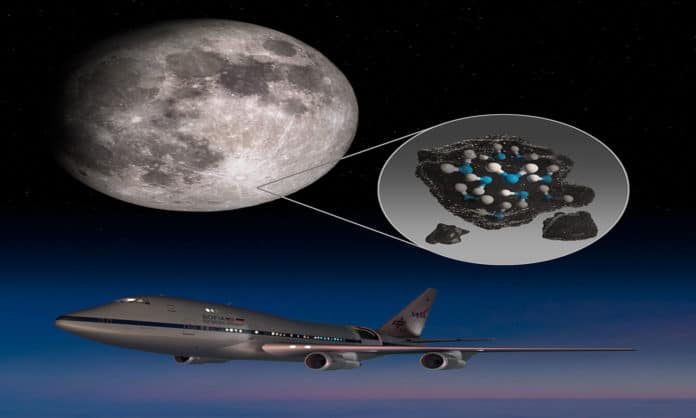Water is a precious resource in deep space and an essential ingredient of life as we know it.
For the first time, NASA’s Stratospheric Observatory for Infrared Astronomy (SOFIA) has confirmed water’s presence on the Moon’s sunlit surface. SOFIA detected water molecules (H2O) in Clavius Crater.
This discovery indicates that water may be distributed across the lunar surface and not limited to cold, shadowed places.
Clavius is one of the largest crater formations on the Moon and the second-largest crater on the visible near side. It is located in the Moon’s southern hemisphere. Data from this location reveal water in concentrations of 100 to 412 parts per million – roughly equivalent to a 12-ounce bottle of water – trapped in a cubic meter of soil spread across the lunar surface.
Casey Honniball, the lead author who published the results from her graduate thesis work at the University of Hawaii at Mānoa in Honolulu, said, “Before the SOFIA observations, we knew there were some hydration. But we didn’t know how much, if any, was actually water molecules – like we drink every day – or something more like drain cleaner.”
SOFIA offers new insights on the Moon. Flying at altitudes of up to 45,000 feet, this modified Boeing 747SP jetliner with a 106-inch diameter telescope reaches above 99% of the water vapor in Earth’s atmosphere to get a clearer view of the infrared universe. Using its Faint Object infraRed CAmera for the SOFIA Telescope (FORCAST), SOFIA could pick up the specific wavelength unique to water molecules, at 6.1 microns, and discovered a relatively surprising concentration in sunny Clavius Crater.
Hannibal said, “Without a thick atmosphere, water on the sunlit lunar surface should just be lost to space. Yet somehow, we see it. Something is generating the water, and something must be trapping it there.”
Scientists noted, “Several forces could be at play in the delivery or creation of this water. Micrometeorites raining down on the lunar surface, carrying small amounts of water, could deposit the water on the lunar surface upon impact. Another possibility is a two-step process whereby the Sun’s solar wind delivers hydrogen to the lunar surface and causes a chemical reaction with oxygen-bearing minerals in the soil to create hydroxyl. Meanwhile, radiation from the bombardment of micrometeorites could be transforming that hydroxyl into water.”
“The water could be trapped into tiny beadlike structures in the soil that form out of the high heat created by micrometeorite impacts. Another possibility is that the water could be hidden between grains of lunar soil and sheltered from the sunlight – potentially making it a bit more accessible than water trapped in beadlike structures.”
SOFIA’s follow-up flights will look for water in additional sunlit locations and during different lunar phases to learn more about how the water is produced, stored, and moved across the Moon. The data will add to the work of future Moon missions, such as NASA’s Volatiles Investigating Polar Exploration Rover (VIPER), to create the first water resource maps of the Moon for future human space exploration.
Journal Reference:
- Honniball, C.I., Lucey, P.G., Li, S. et al. Molecular water detected on the sunlit Moon by SOFIA. Nat Astron (2020). DOI: 10.1038/s41550-020-01222-x
